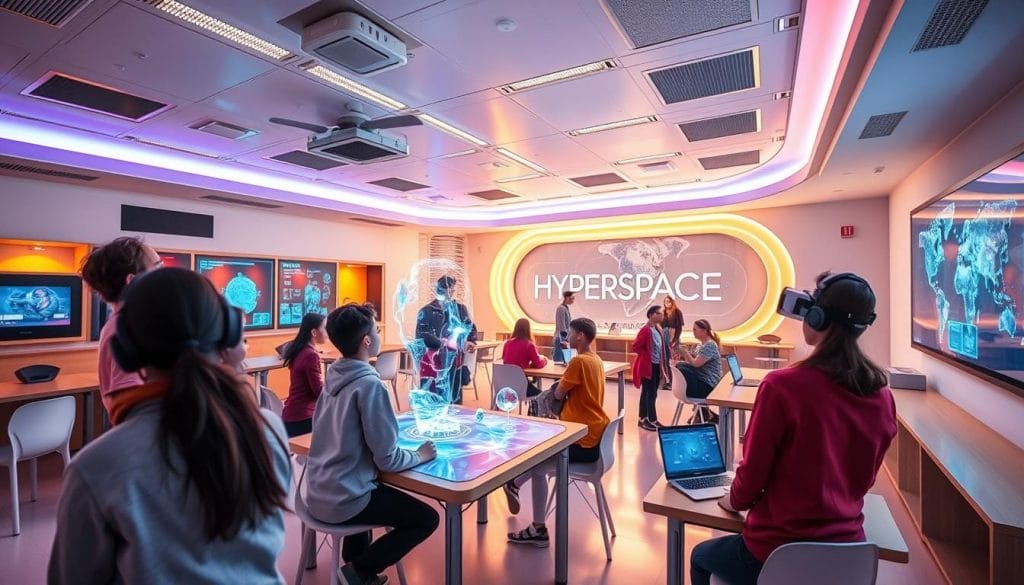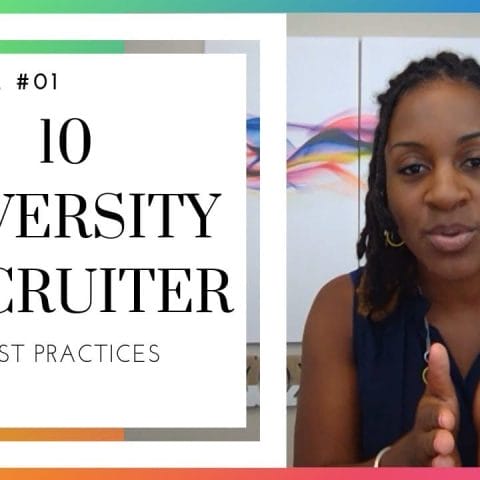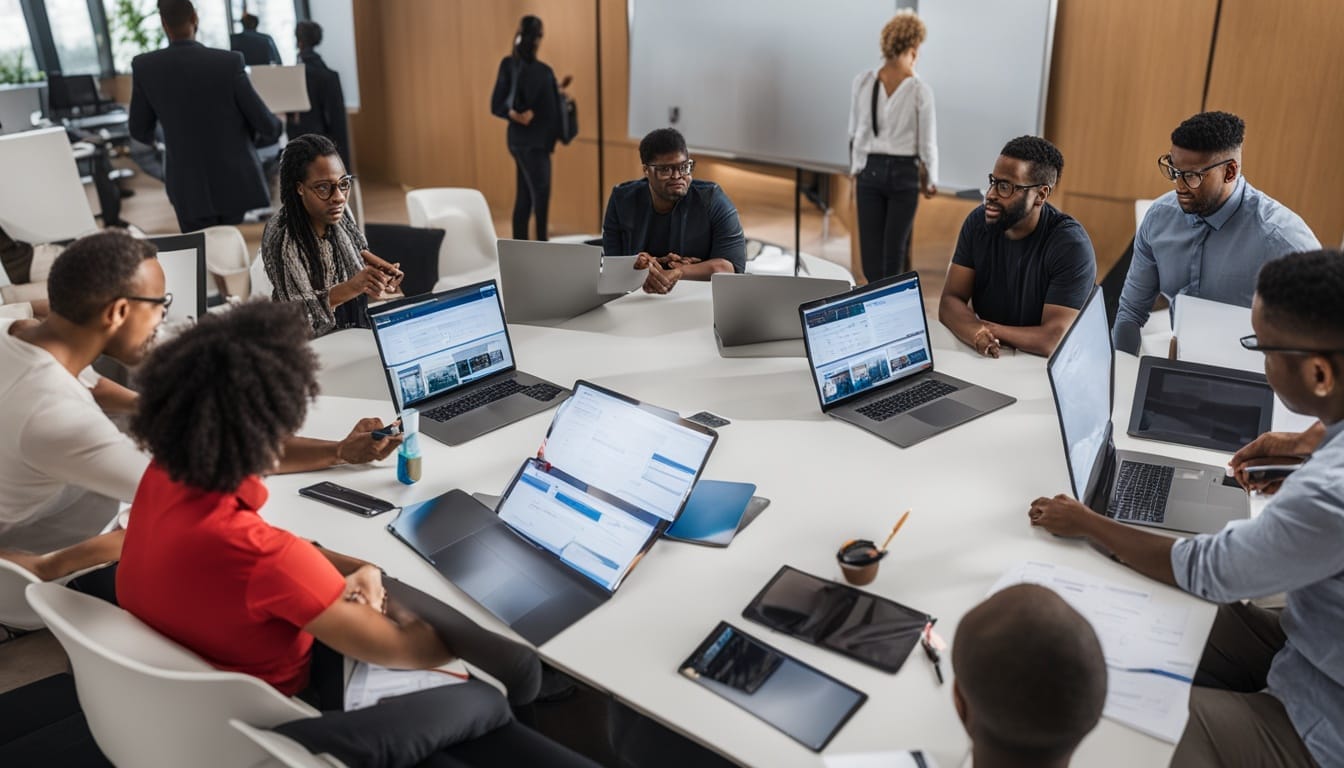Today’s education is fast-paced, and personalized immersive learning is changing the game. It offers tailored learning experiences that fit each student’s needs. Platforms like Hyperspace use VR-ready solutions to make learning more accessible and engaging for everyone.
These immersive experiences can be accessed easily through a browser on any device. This makes education both personalized and convenient. It’s not just about the tech; it’s about creating a learning space where every student can succeed.
Studies show the power of personalized immersive learning. For example, a 2022 study by VictoryXR found that students at Morehouse College who used VR scored an average of 85 on tests. This is much higher than the 78 average of students in traditional settings.
Also, places like the Southeast Louisiana Veterans Health Care System are using VR to help with anxiety and depression. This shows how versatile these educational tools can be.
Key Takeaways
- Personalized immersive learning enhances educational experiences through advanced technologies.
- VR technology can significantly improve student performance, as shown in recent studies.
- Immersive learning is being applied in healthcare to address mental health issues.
- Challenges exist in implementing these technologies, but training programs are helping educators adapt.
- Future trends indicate broader adoption of immersive learning across education sectors.
Understanding the Concept of Immersive Learning

Immersive learning is a new way to learn that uses advanced tech to make learning fun. It uses simulated environments to let learners experience real-world situations. This way, they learn better by doing, not just listening.
Tools like virtual reality (VR) and augmented reality (AR) are key in immersive learning. VR takes you into a digital world, making you feel like you’re really there. AR adds digital stuff to the real world, making learning more interesting. Both help learners in different ways.
Immersive learning is changing how we train in many fields, like healthcare and retail. It lets people practice without the risks of real life. This way, they learn more and remember it better than usual methods.
Today, getting students to engage in learning is more important than ever. Research shows that hands-on learning leads to better career success. Immersive learning makes learning fun and engaging, helping students connect with what they’re learning.
| Aspect | Traditional Learning | Immersive Learning |
|---|---|---|
| Engagement | Passive involvement | Active participation and interaction |
| Retention of Information | Lower retention rates | Higher information retention |
| Learning Environment | Static and confined | Dynamic and simulated |
| Accessibility | Limited to classroom settings | Available on multiple devices |
The move to immersive learning shows we need to keep up with tech. It helps learners not just get knowledge but also skills for the future.
The Role of Technology in Personalized Immersive Learning

Technology is key in making learning personal and immersive. It changes how we learn. It makes learning fit each person’s needs, making it more fun and engaging.
Tools like VR and AR are important in this change. They make learning interactive. Students can dive into content in a way that feels real.
Studies show that these tools make learning fun. A study by Schmid, Pauli, and Petko (2022) found that personalized learning works well. Bower, DeWitt, and Lai (2020) looked at how teachers use VR in class.
VR can help students solve problems, as Araiza-Alba et al. (2021) found. This way, everyone can learn at their own pace.
The Sheboygan Area School District uses ClassVR to make learning exciting. Students use headsets to see and understand things better.
Immersive learning has changed classrooms. It makes learning more fun and effective. Leaders like Michael Jaber think technology will keep improving learning.
Benefits of Personalized Immersive Learning
Personalized immersive learning brings many benefits to students. It makes learning more engaging and meaningful. Studies show that immersive learning environments can lead to better grades.
Kwon (2018) found that VR’s vividness and interactivity make learning more impactful. This is because it feels like a real experience.
Learning becomes even better when it involves teamwork. A study by Van Der Meer et al. (2023) showed that VR helps students work together better, no matter where they are. This teamwork boosts the benefits of personalized learning, helping everyone succeed together.
Immersive learning works well in schools and at work too. Checa & Bustillo (2019) found that VR games make learning faster and more effective. Workers learn up to four times quicker in VR than in regular classrooms.
Immersive learning can help students remember what they learn up to 75% better than traditional methods. This is a big advantage. As companies focus more on training, immersive learning offers a way to grow skills, creativity, and adaptability.
| Learning Method | Retention Rate | Engagement Level | Training Efficiency |
|---|---|---|---|
| Immersive Learning | 75% | High | 4x faster |
| Traditional Learning | 10% | Moderate | Standard Speed |
Interactive Digital Learning: Engaging the Modern Learner
Interactive digital learning uses technology to keep today’s learners engaged. It combines modern teaching methods like gamification. This makes learning fun and interactive.
Students get to play with virtual objects and work together in real-time. They also explore complex ideas in a fun way.
Immersive learning uses VR, AR, and AI to make learning more personal and fun. It helps learners understand better and remember more. In fact, studies show it can make learning four times more effective.
Most learners want to experience this kind of learning again. It’s clear that immersive learning is a hit.
Companies need to check if they have the right setup for immersive learning. Starting might cost more, but it saves time and money in the long run. For example, Banque Populaire du Sud saw a huge increase in employee satisfaction.
They went from 32% to 92% in just a few months. This shows how well these new methods work.
To learn more about using these strategies in your learning space, check out this resource. It offers great tips on making learning more engaging with digital tools.
Customized Educational Experiences for Everyone
Customized educational experiences are key in today’s learning world. They welcome all learners and meet their unique needs. By creating tailored learning pathways, teachers make learning feel personal and inclusive for each student’s individual learning styles.
Immersive technologies like Virtual Reality (VR) are changing the game. VR pulls learners into virtual worlds, making learning fun and memorable. It’s a game-changer in fields like healthcare, where it lets professionals practice without risk.
Augmented Reality (AR) adds a new layer to learning. It brings digital content to life in our real world. Imagine history lessons that feel like adventures, thanks to AR. This approach boosts engagement and meets individual learning styles, helping students learn better.
But, using these technologies isn’t without its hurdles. Costs and access are big challenges. Yet, as tech advances, AI and immersive tech are getting closer. This combo promises to make learning even more personal and effective.
The future of learning looks bright. By focusing on individual learning styles and using immersive tools, teachers can make learning fun and accessible for all.
Personalized Immersive Learning: Adapting to Individual Needs
Personalized immersive learning meets each student’s unique needs. It uses adaptive learning systems to adjust content based on progress and preferences. This creates learning paths that are just right for each student. It helps teachers keep students engaged and improves the learning experience.
Immersive experiences, like virtual and augmented reality, are key in this approach. They make learning fun and focused. Students get feedback right away, helping them understand better.
Students can try new things without fear, learning from their mistakes. This safe space helps them learn and grow. As more schools use immersive learning, it will help workers keep up with new skills.
- Enhances student engagement through immersive activities.
- Offers tailored experiences that cater to individual needs.
- Supports collaboration among learners, fostering teamwork.
- Facilitates continuous feedback to improve understanding.
- Paves the way for advanced skill development and retention.
Exploring Virtual Reality Education
Virtual reality education changes how we learn, making it more fun and interactive. It lets teachers take students on virtual trips to ancient places or inside living cells. This way, hard-to-understand ideas become clear and exciting.
VR simulations make learning more engaging. Students get to try out what they’ve learned in real-life scenarios. This boosts their critical thinking and problem-solving skills. Plus, VR lets everyone learn at their own pace, fitting different learning styles.
- Enhances skill development: VR in classrooms offers hands-on experiences that solidify understanding.
- Encourages collaboration: Virtual classrooms provide real-time interactions among students and educators.
- Global accessibility: VR eliminates geographical barriers, allowing for worldwide educational collaboration.
- Fosters cultural exchange: Diverse perspectives enrich learning experiences in a virtual setting.
Adaptive learning technologies make learning more personal in the metaverse. They help create learning spaces that match each student’s needs and interests. Workshops like the Immersive Experience Club and the Extended Reality Field Trip help teachers learn how to use VR in class.
As virtual reality education grows, it’s clear it’s changing education for the better. Schools using VR can create engaging learning spaces. These spaces help students get ready for today’s world.
The Impact of AI-Enhanced Education on Learning
AI is changing how we teach and learn. Intelligent tutoring systems offer personalized learning. They adjust content based on how well students do, making sure everyone gets the right help.
These systems use data to predict who might struggle. They can spot students at risk early on. This way, teachers can help them before it’s too late.
Adaptive technology makes learning more fun by tailoring it to each student. It suggests content that fits their needs. AI helps design lessons that match what each student knows and needs to learn.
This approach boosts how well students do. They often learn more than they would with old teaching methods.
AI also helps make learning fair for everyone. It supports students with special needs and makes sure they have the same chances as others. Virtual and augmented reality make learning feel real and exciting.
AI chatbots are always ready to help. They answer questions and make learning more engaging in many subjects.
But, there are worries about AI’s fairness and how it keeps student data safe. Teachers need training to use AI well. They must learn to use new tools while keeping an eye on the whole student.
Tailored Learning Programs: Ensuring Success for All Students
Tailored learning programs are key in today’s education. They help students of all kinds succeed. These programs meet each student’s unique needs, creating a place where everyone can grow.
Studies show that 93% of teachers believe personalized learning boosts student success. This shows how well it works in schools.
These programs make learning fit each student’s path. This approach not only helps students do better but also makes them more interested in learning. For example, 78% of students say they like learning more when it’s personalized.
Companies that use these programs also see big benefits. They report a 42% jump in keeping employees. This shows how effective tailored learning can be in all areas.
Technology makes these programs even better. Interactive tools can make learning 50% more engaging. Games in courses can increase completion by 30%. This tech helps students stay interested and remember what they learn better.
| Aspect | Impact |
|---|---|
| Increase in Student Outcomes | 93% of educators agree |
| Employee Retention | 42% increase |
| Learner Satisfaction | 60% increase with adaptive paths |
| Knowledge Retention | Up to 25% better with custom solutions |
| Engagement from Assessments | Improves by up to 50% |
| Completion Rates with Gamification | 30% increase |
As education changes, tailored learning programs are more important than ever. They offer the tools and ways to make learning inclusive. With AI and adaptive learning, the future of education looks bright and more accessible.
Challenges in Implementing Immersive Learning Technologies
Using immersive learning technologies comes with big challenges. One major issue is the high cost of tools like Virtual Reality (VR) equipment. This makes it hard for schools to use the latest learning methods.
Another problem is getting used to new tech. Teachers and students might find it hard to use these tools well. If they struggle, they might not stay engaged.
- High Costs: The cost of new tech can stop schools from getting it.
- Learning Curves: It can take time for people to get good at using new systems.
- Content Development: Making learning content for VR takes a lot of time and effort.
- Accessibility: Some VR tools might not work for people with physical disabilities.
- Feedback Challenges: Giving feedback in VR can be tricky.
- Quality Consistency: Keeping the quality of VR experiences the same is hard.
- Lack of Standards: There are no clear rules for making VR learning materials.
- Resistance to Change: Schools might be hesitant to try new tech because of the risks.
Having good infrastructure is key. Content Delivery Networks (CDNs) need to handle the big data needs of VR. This ensures that learning materials are delivered smoothly, making the experience better. Without the right setup, tech problems can mess up learning.
To make immersive learning work, we need to tackle these challenges head-on. We need solid plans and investments in training, tech, and making learning content. This will help us overcome these obstacles and make learning better for everyone.
The Future of Personalized E-Learning Solutions
The future of e-learning looks bright as technology gets better and more people can use it. Trends in immersive learning show a move towards more interactive and flexible learning. Schools are starting to use virtual reality, augmented reality, and artificial intelligence to improve teaching and learning.
Personalized learning is key to keeping students interested and helping them learn more. It means teaching in a way that fits each student’s needs. For example, advanced e-learning tools can understand how students learn by analyzing their actions.
| Type of Analytics | Description | Purpose |
|---|---|---|
| Descriptive Analytics | Reports on past events such as completion rates and frequently accessed resources | Gather insights into learners’ progress |
| Predictive Analytics | Utilizes past patterns to anticipate future outcomes | Identifies learners at risk of falling behind |
| Diagnostic Analytics | Explores reasons behind learner performance | Facilitates understanding of specific challenges |
| Prescriptive Analytics | Recommends actions for improving learning outcomes | Guides intervention strategies |
Adaptive learning systems will soon adjust to each student’s pace and needs. They will predict what students need to learn next, based on their interests and future plans. Adding game elements to learning will make it more fun and engaging.
The future of e-learning is about working together, being inclusive, and making learning more efficient. As schools use new technologies, immersive learning will keep growing.
Hyperspace: Your Partner in Immersive Learning Experiences
Hyperspace is a leader in personalized immersive learning. This immersive technology partner brings unique Hyperspace solutions to schools. They make learning fun and interactive.
Hyperspace’s platform works well on many devices. This means teachers can easily use immersive tech without special hardware.
Hyperspace’s education technology service is very flexible. Schools can use cool features like simulations and games. This makes learning better for all students.
AI helps make learning personal. Hyperspace tailors each student’s path to fit their needs.
Working with Hyperspace can really improve teaching. Schools can use immersive tech to get students ready for the real world.
Tools that promote teamwork and thinking are part of Hyperspace’s offer. This changes education, making it more meaningful and fun.
Hyperspace has strong partnerships and lots of experience. They’re changing immersive learning for the better. Their focus on custom training makes learning fit today’s world.
Conclusion
Personalized immersive learning is changing education fast. It makes sure every learner gets what they need in fun, interactive ways. With tech like virtual reality (VR) and augmented reality (AR), we can make learning places that help grow skills and keep knowledge.
This method not only makes learning more fun but also improves skills in areas like healthcare and manufacturing. It helps create a more skilled workforce for the future.
Looking to the future, using immersive learning tech in schools is key. Studies show 77% of learning experts want personalized learning to boost engagement. This approach helps learners deal with boring content and improves teamwork skills.
Companies like Hyperspace are leading the way in immersive learning. They’re making education better for tomorrow’s challenges. By facing and solving the challenges of using new tech, teachers can give learners amazing experiences that last a lifetime.





